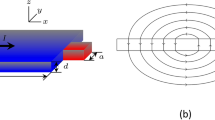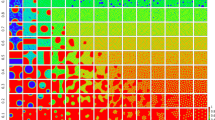Abstract
A serious obstacle impeding the application of low- and high-temperature superconductor devices is the presence of trapped magnetic flux1,2: flux lines or vortices can be induced by fields as small as the Earth's magnetic field. Once present, vortices dissipate energy and generate internal noise, limiting the operation of numerous superconducting devices2,3. Methods used to overcome this difficulty include the pinning of vortices by the incorporation of impurities and defects4, the construction of flux ‘dams’5, slots and holes6, and magnetic shields2,3 which block the penetration of new flux lines in the bulk of the superconductor or reduce the magnetic field in the immediate vicinity of the superconducting device. The most desirable method would be to remove the vortices from the bulk of the superconductor, but there was hitherto no known phenomenon that could form the basis for such a process. Here we show that the application of analternating current to a superconductor patterned with an asymmetric pinning potential can induce vortex motion whose direction is determined only by the asymmetry of the pattern. The mechanism responsible for this phenomenon is the so-called ‘ratchet effect’7,8,9,10, and its working principle applies to both low- and high-temperature superconductors. We demonstrate theoretically that, with an appropriate choice of pinning potential, the ratchet effect can be used to remove vortices from low-temperature superconductors in the parameter range required for various applications.
This is a preview of subscription content, access via your institution
Access options
Subscribe to this journal
Receive 51 print issues and online access
$199.00 per year
only $3.90 per issue
Buy this article
- Purchase on Springer Link
- Instant access to full article PDF
Prices may be subject to local taxes which are calculated during checkout



Similar content being viewed by others
References
Tinkham, M. Introduction to Superconductivity (McGraw-Hill, New York, 1996).
Donaldson, G. B., Pegrum, C. M. & Bain, R. J. P. in SQUID '85: Proc. 3rd Int. Conf. on Superconducting Quantum Devices (eds Hahlbohm, H. D. & Lübbig, H.) 749–753 (Walter Gruyter, Berlin, 1985).
Clarke, J. Superconducting Devices (eds Ruggiero, S. T. & Rudman, D. A.) 51–100 (Academic, 1990).
Blatter, G., Feigelman, M. V., Geshkenbeim, V. B., Larkin, A. I. & Vinokur, V. M. Vortices in high temperature superconductors. Rev. Mod. Phys. 66, 1125–1388 (1994).
Koch, R. H., Sun, J. Z., Foglietta, V. & Gallagher, W. J. Flux dam, a method to reduce extra low-frequency noise when a superconducting magnetometer is exposed to a magnetic field. Appl. Phys. Lett. 67, 709–711 (1995).
Dantsker, E., Tanaka, S. & Clarke, J. High-Tcsuperconducting quantum interference devices with slots or holes: low 1/f noise in ambient magnetic fields. Appl. Phys. Lett. 70, 2037–2039 (1997).
Magnasco, M. O. Forced thermal ratchet. Phys. Rev. Lett. 71, 1477–1481 (1993).
Astumian, R. D. Thermodynamics and kinetics of a brownian motor. Science 276, 917–922 (1997).
Jülicher, F., Ajdari, A. & Prost, J. Modeling molecular motors. Rev. Mod. Phys. 69, 1269–1281 (1997).
Hänggi, P. & Bartussek, R. in Lecture Notes in PhysicsVol. 476 (eds Parisi, J. et al.) 294–308 (Springer, Berlin, 1996).
Clem, J. R., Huebener, R. P. & Gallus, D. E. Gibbs free-energy barrier against irreversible magnetic flux entry into a superconductor. J. Low Temp. Phys. 12, 449–477 (1973).
Mück, M. Practical aspects for SQUID applications. Superlattices Microstruct. 21, 415–421 (1997).
Scott, B. A., Kirtley, J. R., Walker, D., Chen, B.-H. & Wang, Y. Application of scanning SQUID petrology to high-pressure materials science. Nature 389, 164–167 (1997).
Rousselet, J., Salome, L., Ajdari, A. & Prost, J. Directional motion of brownian particles induced by a periodic asymmetric potential. Nature 370, 446–448 (1994).
Faucheux, L. P., Bourdieu, L. S., Kaplan, P. D. & Libchaber, A. J. Optical thermal ratchet. Phys. Rev. Lett. 74, 1504–1507 (1995).
Kelly, T. R., Silva, H. D. & Silva, R. A. Arationally designed molecular motor. Nature(submitted).
Derényi, I., Lee, C.-S. & Barabási, A.-L. Ratchet effect in surface electromigration: smoothing surfaces by an AC field. Phys. Rev. Lett. 80, 1473–1476 (1998).
Zapata, I., Bartussek, R., Sols, F. & Hänggi, P. Voltage rectification by a SQUID ratchet. Phys. Rev. Lett. 77, 2292–2295 (1996).
Zapata, I., Luczka, J., Sols, F. & Hängii, P. Tunneling center as a source of voltage rectification in Josephson junctions. Phys. Rev. Lett. 80, 829–832 (1998).
Reichhardt, C., Olson, C. J. & Nori, F. Nonequilibrium dynamic phases and plastic flow of driven vortex lattices in superconductors with periodic arrays of pinning sites. Phys. Rev. B 58, 6534–6564 (1998).
Reichhardt, C., Olson, C. J. & Nori, F. Dynamic phases of vortices in superconductors with periodic pinning. Phys. Rev. Lett. 78, 2648–2651 (1997).
Olson, C. J., Reichhardt, C. & Nori, F. Nonequilibrium dynamic phase diagram for vortex lattices. Phys. Rev. Lett. 81, 3757–3760 (1998).
Zeldov, E.et al. Geometrical barriers in high-temperature superconductors. Phys. Rev. Lett. 73, 1428–1431 (1994).
Acknowledgements
We thank R. D. Astumian, D. J. Bishop, S. N. Coppersmith, D. Grier, H. Jeong, A.Koshelev and S. T. Ruggiero for discussions and help during the preparation of the manuscript. This research was supported by an NSF Career Award.
Author information
Authors and Affiliations
Corresponding author
Rights and permissions
About this article
Cite this article
Lee, CS., Jankó, B., Derényi, I. et al. Reducing vortex density in superconductors using the ‘ratchet effect’. Nature 400, 337–340 (1999). https://doi.org/10.1038/22485
Received:
Accepted:
Issue Date:
DOI: https://doi.org/10.1038/22485
This article is cited by
-
Role of translational noise on current reversals of active particles on ratchet
Scientific Reports (2023)
-
Catastrophic magnetic flux avalanches in NbTiN superconducting resonators
Communications Physics (2023)
-
Anomalous transverse resistance in the topological superconductor β-Bi2Pd
Nature Communications (2022)
-
Demonstration of a superconducting diode-with-memory, operational at zero magnetic field with switchable nonreciprocity
Nature Communications (2022)
-
Superconducting diode effect via conformal-mapped nanoholes
Nature Communications (2021)
Comments
By submitting a comment you agree to abide by our Terms and Community Guidelines. If you find something abusive or that does not comply with our terms or guidelines please flag it as inappropriate.



